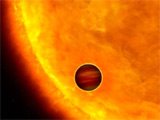16 planets are found outside solar system:
Astronomers have peered deep into space and discovered a new class of close-orbiting planets outside the solar system.
Some of the planets cling so closely to their parent stars they can complete a full orbit in less than a day.
The earth, by comparison, takes a year to orbit the sun.
The "planet candidates," which are 26,000 light-years away from Earth, were spotted using NASA's Hubble telescope.
Between eight and 16 of the planets were discovered near the centre of the Milky Way. They are the most distant planets discovered so far,
and probably serve as an indication that the Milky Way is home to billions of other undiscovered planets as well, Mario Livio, an astronomer at the Space Telescope Institute in Baltimore told CTV's Canada AM.
"Until now we know of about 200 or so planets around other stars but they are all kind of in the solar neighborhood, they are in our back yard," Livio said.
"Now with the Hubble we looked halfway across the galaxy, 26,000 light years, and found that near the centre of the galaxy there are also all these planets."
A light year is the distance that light travels in one year -- about six trillion miles.
Astronomers have labelled them "candidate" planets, because they cannot yet fully confirm the mass of the objects. However they believe "at least half of them if not all of them are real planets," Livio said.
Scientists have long theorized that planets exist outside our solar system, and since 1993 astronomers have located about 200 planets. Many of them are gaseous, and are locked in close orbit with their parent star, similar to Jupiter.
They are known as "hot Jupiters."
The recently discovered planets fit the same description, though they orbit their stars -- which are smaller than the sun -- more quickly than Jupiter. One of the planets completes a full orbit in just 10 hours.
Scientists believe the temperature on these planets is about 1,650 C. From the surface of the planet, the parent stars would fill up one third of the sky from the horizon to the zenith, said Kailash Sahu, Space Telescope Science Institute astronomer who led the team.
Lizio said the discovery opens the debate about life on other planets.
"It doesn't yet mean much in the sense that we cannot yet discover things like earth and things like life, but the fact we find planets are everywhere in the galaxy, the chances of life being elsewhere is definitely something we should talk about."
The scientists discovered the planets by studying a star field near the centre of the galaxy. They monitored 180,000 stars and discovered 16 that they believe are planets.
story of here
Hot and Sexy New Myanmar Model Shwe Sin| Hot Photo Set
-
Hot and Sexy New Myanmar Model Shwe Sin| Hot Photo Set
The hot photo set of new sexy Myanmar model Shwe Sin. The colors are hot
pink,black and bright yello...






Megan_Fox_6+copy.jpg)









0 comments:
Post a Comment